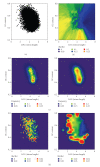Adaptive Evolution Hotspots at the GC-Extremes of the Human Genome: Evidence for Two Functionally Distinct Pathways of Positive Selection
- PMID: 20454629
- PMCID: PMC2862947
- DOI: 10.1155/2010/856825
Adaptive Evolution Hotspots at the GC-Extremes of the Human Genome: Evidence for Two Functionally Distinct Pathways of Positive Selection
Abstract
We recently reported that the human genome is ''splitting" into two gene subgroups characterised by polarised GC content (Tang et al, 2007), and that such evolutionary change may be accelerated by programmed genetic instability (Zhao et al, 2008). Here we extend this work by mapping the presence of two separate high-evolutionary-rate (Ka/Ks) hotspots in the human genome-one characterized by low GC content, high intron length, and low gene expression, and the other by high GC content, high exon number, and high gene expression. This finding suggests that at least two different mechanisms mediate adaptive genetic evolution in higher organisms: (1) intron lengthening and reduced repair in hypermethylated lowly-transcribed genes, and (2) duplication and/or insertion events affecting highly-transcribed genes, creating low-essentiality satellite daughter genes in nearby regions of active chromatin. Since the latter mechanism is expected to be far more efficient than the former in generating variant genes that increase fitnesss, these results also provide a potential explanation for the controversial value of sequence analysis in defining positively selected genes.
Figures




References
-
- Levasseur A, Orlando L, Bailly X, Milinkovitch MC, Danchin EGJ, Pontarotti P. Conceptual bases for quantifying the role of the environment on gene evolution: the participation of positive selection and neutral evolution. Biological Reviews. 2007;82(4):551–572. - PubMed
-
- O’Loughlin TL, Patrick WM, Matsumura I. Natural history as a predictor of protein evolvability. Protein Engineering, Design and Selection. 2006;19(10):439–442. - PubMed
-
- Templeton AR. The reality and importance of founder speciation in evolution. BioEssays. 2008;30(5):470–479. - PubMed
LinkOut - more resources
Full Text Sources
Miscellaneous

